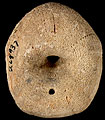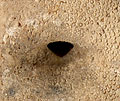|
Diagnostic Features
|
-
Test of medium size, elongate to subcircular in outline; margin and adoral surface rounded, sunken towards peristome
-
Apical system subcentral, monobasal, with four gonopores. Sexual dimorphism in size of genital pores (larger in females)
-
Petals well developed, open distally, anterior petal III longest, posterior pair (V & I) shortest. Pores strongly conjugate, equal number of pores in pores series in the same petal. Ambulacra beyond petals composed of primary plates, demiplates, and in some species included plates; demiplates and included plates small, thin, not reaching interior of test, absent near peristome
-
Peristome subcentral, opening subpentagonal to subtrigonal, in deep transverse depression or trough
-
Periproct inframarginal, midway between peristome and posterior margin
-
Buccal pores present on edge of peristome
-
Tubercles small, irregularly arranged both adorally and adapically
|
|
Distribution
|
Middle to Late Eocene of southern USA, Central America, the West Indies and the Caribbean
|
| Name gender |
masculine |
| Type |
-
Oligopygus wetherbyi de Loriol, 1887, p. 395; by monotypy.
|
| Species Included |
-
O. costuliformis Jeannet, 1928; Late Eocene, Trinidad
-
O. curasavica Molengraaff, 1929; Upper Eocene, Curacao
-
O. haldemani (Conrad, 1850); Late Eocene, Florida
-
O. jamaicensis Arnold & Clark, 1927; Middle Eocene, Jamaica
-
O. kugleri Jeannet, 1928; Late Eocene, Trinidad
-
O. nancei Cooke, 1941; Late Eocene, Venezuela
-
O. phelani Kier, 1967; Late Eocene, Florida, USA
-
O. pinguis Palmer in Sanchez Roig, 1949: Middle-Late Eocene, Cuba
-
O. putnami Israelsky; 1933; Upper Eocene, Mexico
-
O. rotundus Cooke, 1942; Late Eocene, Alabama, USA
-
O. sanchezi Lambert, 1932; Middle Eocene, Cuba
-
O. wetherbyi de Loriol, 1888; Late Eocene, Florida, USA
-
O. zyndeli Jeannet, 1928; Late Eocene, Trinidad
|
| Classification and/or Status |
Irregularia; Neognathostomata, Stem group Clypeasteroida; Oligopygidae
Presumed monophyletic
|
| Remarks |
Oligopygus is similar to Haimea, except that in Oligopygus the opening of the peristome is situated in a deep transverse trough, while in Haimea the peristomal opening is flush with the test and sometimes with slightly developed bourrelets. The plate sutures in Oligopygus are reported to be corrugated, but smooth in Haimea (Kier, 1967, p. 52).
P. M. Kier. 1967. Revision of the oligopygoid echinoids. Smithsonian Miscellaneous Collections 152 (2), 149 pp., 36 pls.
de Loriol, P. 1887. Notes pour servir à l’étude des échinodermes, 2. Recueil zoologique Suisse, 4, 365-407, pls 15-18.
|





